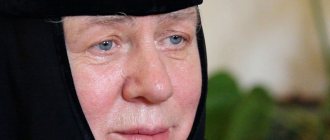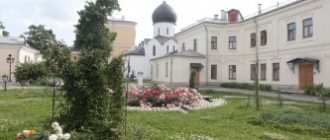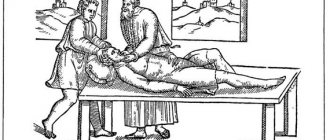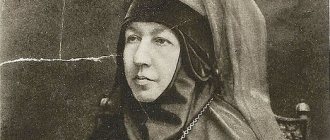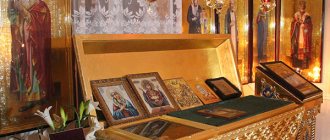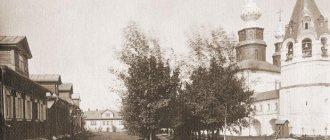| Igum. Paraskeva (Rodimtseva) |
Paraskeva (Rodimtseva)
(1849 - 1928), abbess of the Toplovsky Monastery, Venerable Memory of December 3 (Simfer.)
In the world, Olga Ivanovna Rodimtseva was born in 1849 in Moscow into a pious merchant (according to other sources, bourgeois) family.
In 1871, at the age of 22, she entered the Moscow Passion Monastery.
In 1874, she was identified as a sister and clothed in a ryassophore with the name Vyacheslava.
In 1875, the abbess of the Passionate Monastery Valeria (Bode) received the blessing to move to the Toplovsky Monastery and wished to take the nun Vyacheslava with her. Faithful to monastic obedience, she happily agreed.
In the Toplovskaya monastery, nun Vyacheslava from the very first days showed herself to be a zealous ascetic, seeking strictly monastic work. Constant exercises in fasting and prayer, reading the Holy Scriptures and the Holy Fathers bore fruit. Her sobriety and prudence were noted by the sisters, and her wise stewardship by the clergy. And soon, with the unanimous approval of the nuns, she was elected secretary of the monastery council, and later treasurer.
On June 16, 1889, she was tonsured a monk and given the name Paraskeva by Bishop Martinian (Muratovsky) of Tauride.
In December of the same year, she was appointed abbess of the monastery, and on July 26, 1890, she was elevated to the rank of abbess.
Mother led a strict ascetic life, prayed unceasingly, was meek, non-covetous and hospitable. Through the labors and prayers of the Venerable Paraskeva, the Toplovskaya monastery was established, the three-altar Holy Trinity Cathedral was built, as well as other churches on monastery farmsteads in Feodosia, Simferopol, Old Crimea and Kerch, and many church and utility buildings. Thanks to significant donations, an orchard was laid out in the monastery, and two farms were organized for household needs. In 1897, on the initiative of Abbess Paraskeva, a hospital with a house church was erected in honor of the icon “Joy of All Who Sorrow.” A separate house was built for the clergy, as well as a small church and school at the Kazan courtyard in Feodosia.
After the revolution, all the lands and gardens that were so successfully cultivated by the sisters of the monastery were transferred to the state. A “Soviet sanatorium” was organized on the territory of the monastery. In order to preserve the statutory monastic life of the monastery, Abbess Paraskeva proposed the creation of a women’s agricultural artel, which later received the name “Women’s Labor” and was registered in 1922. This wise decision saved the monastery for some time. As before, the Divine Liturgy was celebrated daily, and the sisters carried out the usual obediences. The abbess said to her closest assistant, nun Polyxenia (Shlyakhova): “Watch carefully so that not one of the monastic laws contained in the teachings of the apostles and the tradition of the holy fathers is forgotten. Keep holy the blessed and unanimous community"
.
| Icon of St. Paraskeva Toplovskaya |
The atheists turned to the Crimean Central Executive Committee with a request to “approve the liquidation of the churches of the former Toplovsky Monastery,” and the churches were sealed. The believers of the surrounding villages opposed this and submitted an application to the Crimean Central Election Commission for the return of the sealed churches. The spiritual uplift was so great that one can speak without exaggeration about the feat of confession of ordinary peasants who decided to stand up for their shrines. The atheists knew that Abbess Paraskeva was behind all this, but they could not do anything. The churches were not opened, but the believers did not give up. According to spiritual reasoning, the abbess and her sisters decided to ignore the ever-increasing pressure from the authorities and threats of possible reprisals; their main attention was focused on internal work. The abbess taught the sisters “to be always ready to die for the faith of Christ, for the purity of the teachings of the Orthodox Church of God”
and said that she was
“confident in the Lord that each of you, both old and young, by the grace of the Holy Spirit will never betray the saint in one iota.” Orthodoxy, will accept torture and even death for all the truth of God.”
On September 7, 1928, the authorities liquidated the Women's Labor agricultural artel.
Abbess Paraskeva died on December 16, 1928 from cardiac paralysis, having been ill for only an hour and a half. Before her death, she confessed and received the Holy Mysteries of Christ. Abbess Paraskeva was buried in the monastery cemetery. But her grave was plundered by “treasure” seekers. In the early 1980s, workers wanted to take a monument from the monastery cemetery for a mass grave. But when the tombstone was lifted and turned over, it turned out that it belonged to Abbess Paraskeva, as evidenced by the words: “Here lie the honest relics of Abbess Paraskeva. The prayer candle of her soul burned for half a century with great and fiery love, with petitions for the monastery of this saint to the Lord. We love, we bow to you, our kind and wise mother. 3. XII. 1928 (O.S.)"
. Now the tombstone is inside the chapel.
Abbess Paraskeva was canonized as a locally revered saint of the Simferopol diocese by the decision of the Holy Synod of the Ukrainian Orthodox Church on March 25, 2009. Remembrance Day is set to take place on December 3. On July 11, 2010, the solemn glorification of the holy Venerable Paraskeva of Toplovskaya took place. The rank was headed by Metropolitan of Kiev and All Ukraine Vladimir (Sabodan). On the day of glorification, July 11, the memory of St. is also celebrated at the Toplovskaya monastery. Paraskeva [1].
The relics of the saint were found and underwent an examination, which fully confirmed their authenticity. Now they are in the Paraskevi temple of the monastery.
Prayers
Troparion, tone 4
Our venerable mother Paraskeva, / you despised the wealth and glory of this world, / from your youth you were disheartened by the most beautiful Christ above all, / the cross to the ground and from it did not even descend to death Further./ You brought purity of soul and body to the Lord as a gift,/ through bloodless suffering to Him You have pleased us:/ You are now in the Heavenly abode,/ Remember us who honor your glorious memory.
Troparion, tone 1
From your youth you were ignorant of Christ/ and to Him alone you worked, God-wise Paraskevo./ When the predatory God-fighters surrounded your God-saved abode,/ crowned with the feat of confession Thank you./ Likewise, instruct us in virtues with love to stand firmly/ in the Orthodox faith and piety.
Kontakion, tone 2
You dwelt in the monastery of Toplovstey, blessed Paraskeva, / you despised worldly rebellion and human deceit. / Likewise, God exalted you in times of fierce persecution. / Strengthen the faint-hearted and protect the mouth of those who blaspheme the Holy Church, / deliver us from all evils found / through your prayers and with tenderness those who call:/ Rejoice, praise and affirmation of our earth.
Prayer to Venerable Paraskeva Toplovskaya
Oh, our reverend and wise mother Paraskevo! In this temporal life, you have become accustomed to working unceasingly for Christ, you have remained everlasting in obedience, fasting and prayer, you have lived a godly life and won an unfading crown of glory! Accept this small prayer of ours, offered to you with love and tears. Enlighten our darkness with the bright rays of your divine virtues. Pour upon us, your children, the oil of your mercies and blessings. Soften the scabs of sin, heal the wounds of soul and body, visit and console those who are infirm. Oh, our blessed and meek mother, do not leave us orphans! And just as you did not leave your abode after your dormition, being there in body and soul in heaven, so now do not leave us in the virtue of the poor. Deliver us, by your omnipotence, even to God, by intercession from the troubles and temptations that come upon us today through our sin. Beg the Lover of Mankind, Christ, to grant us remission of sins, so that we may pass through this temporary life without restraint and enter into eternal joy with all the saints. Amen.
Monastery of the Three Paraskeva
The state policy of that time assumed the active settlement of these territories, and within the framework of this policy, immigrants from various provinces of Russia and settler colonists from Western Europe poured into Crimea. In addition, many lands were generously donated. In particular, in 1787, Empress Catherine II, during a trip to the Crimea, granted her valet, the Taganrog Greek Zakhar Konstantinovich Zotov, lands in the Sudak district, including the Toplu tract. Ruler of the Tauride region V.V. Kakhovsky reported to Prince Potemkin: “By order of His Serene Highness, I am transmitting the plan for the dacha for Zakhar Konstantinovich. It lies near Kishlau. The location is pleasant, the land is good and all the benefits to the farm are available.” Indeed, in terms of the abundance of water and good soil, the valley was one of the most fertile in Crimea.
Since then, the Toplu tract with the miraculous spring was owned by the descendants of Zakhar Zotov, and by the time of the events described, it was inherited by Feodora Alekseevna Zotova. Feodora had a sister, Angelina Alekseevna, the widow of the titular councilor, provincial secretary Yuri Lambiri, who died in 1860. Being childless and having no heirs, she decided during her lifetime to invest her funds in a charitable cause. Knowing well what kind of source was in their possession, she acquired from Theodora 230 acres of arable, hay, garden and forest land, acquired for a specific purpose - Angelina Lambiri wanted a monastery to be opened here in the name of St. Venerable Martyr Paraskeva, where women inclined towards monasticism could find shelter, because at that time there was not a single convent in Crimea.
On June 29, 1862, Angelina Lambiri turned to Bishop Alexy with a request to establish a women’s monastery at the source and reported that she was donating the 230 acres of land she had acquired. At the same time, the condition was set that half of the income from the land would go to the maintenance of the monastery, and the second half would be given for life to sisters Angelina and Theodora, who wanted to live in the monastery. After the death of the sisters, the land plot becomes the sole and eternal possession of the monastery. It is easy to imagine with what joy this news was greeted. What constituted the main obstacle - private property - was eliminated, and in the most pious and godly manner.
While the Holy Synod was considering the petition for the Highest permission to open the monastery and accept the gift, His Eminence Alexy began to act. On September 17, 1862, a construction committee was formed, which was supposed to find funds and begin building a temple at the source. The committee consisted of the rector of the Kiziltash cinnovia, hegumen Parfeniy (killed by the Tatars on August 22, 1866), a priest from the village of Sala (now the village of Grushevka) Ioann Novitsky, the Kishlava churchwarden Job Uzunbeev and the Kishlava sexton Stefan Miho. Abbot Parthenius was given a collection book for donations from the consistory, and sexton Miho was supposed to look after the building materials.
Funds for the construction of the church were collected very quickly, and already in May 1863. The construction committee began construction of the temple, which was built in an unprecedentedly short time, almost two months, and was completely finished by July 22 of the same year. The construction was carried out so quickly thanks to the extraordinary energy and economic activity of the Kiziltash abbot Parthenius. He created in a short time from a poor monastery a prosperous monastery in the name of St. Stephen of Sourozh, and now, with the blessing of Bishop Alexy, he helped the new monastery, often coming here on horseback through the mountains from Kiziltash. The first monastery church in the name of St. Martyr Paraskeva is, to some extent, a monument to Abbot Parthenius, who suffered a martyr’s death at the hands of murderers.
The temple turned out to be small, with an area of only 5 square meters. fathoms, but this was enough for that period. It was surrounded by a covered gallery where worshipers stood. The floor in the temple was wooden, and in the gallery - clay, the nuns repaired it every week, smoothly filling cracks and potholes. His Eminence Alexy ordered that church utensils, priestly vestments and a bell weighing 12 pounds, from things collected by the wanderer Andronik, later a monk of the Kiziltash monk, be transferred to the church. The construction committee purchased the other two bells in Simferopol. Clothes for the throne and altars were issued from the bishop's Cross Church.
On the day of remembrance of St. Venerable Martyr Paraskeva, July 26, 1863, Vladyka Alexy, in front of a large crowd of people, solemnly consecrated the newly built church, and from that day services began in it. First, the elderly hieromonk Pavel, who had been at this church until 1868, was sent here to serve here from the Kiziltash monastery, and then his place was taken by the hieromonk of the Bakhchisarai Dormition Monastery Procopius, who for many years was the spiritual mentor of the nuns of the Paraskeviev monastery.
The Toplovsky Monastery opened on September 25, 1864. On this day, at 9 o’clock in the morning, a religious procession from the Church of the Ascension in the village of Kishlav, with an icon of St. Sergius, ascended the monastery mountain. Bishop Alexy served a prayer service at the miraculous spring, and after the prayer service in the church of St. Venerable Martyr Paraskeva performed the Divine Liturgy, at the end of which he addressed a word of instruction to the nine nuns of the monastery, among whom was the elderly Bulgarian Constantina.
For the newly opened monastery, from the rules adopted in the Arzamas, Ardatov, Diveyevo and Zvenigorod women's communities, the consistory drew up a charter, applied to local conditions. On January 25, 1865, Bishop Alexy handed it over through Abbot Parthenius to those working in the monastery. In addition, Abbot Parthenius was appointed trustee of the monastery; he had to, if necessary, help the sisters in setting up the monastery and elect the abbess of the monastery.
Toplovsky Monastery today
The revival of the Toplovsky convent began in 1992, when a meeting of believers in the villages of Uchebnoye and Topolevka decided to create an Orthodox community of the “Joy of All Who Sorrow” church. They turned to the Council of Ministers of Crimea and the chairman of the Belogorsk Council of People's Deputies with a request to return the temple, which at that time housed a gym and a billiard room.
The first Divine Liturgy on August 8, 1992 was performed by Archimandrite Philip (Stetsyurenko), a teacher at the Odessa Seminary, he was assisted by Archpriest Alexey Emelianenko, dean of the Belogorsk district, rector of the St. Nicholas Church in the city of Belogorsk and priest Vladimir Karpets (now deceased), rector of the Assumption Church in the city of Old Crimea . They weren’t allowed into the church, so the service was held in the park, in the open air. After the liturgy, a prayer service was held with the blessing of water. This day coincided with the 130th anniversary of the foundation of the first monastery church.
On June 8, 1993, the Council for Religious Affairs under the Cabinet of Ministers of Ukraine registered the charter of the Toplovsky St. Paraskevievsky Convent, and nun Alevtina (Latay) (now deceased), elevated to the rank of abbess, became its abbess. It was on her shoulders that the heavy worries of restoring the monastery fell. She ruled the monastery until 1996, and then retired to the Intercession Monastery in Kyiv. She was replaced by her elder sister, nun Raphaila (Krasnova). And in 1998, the name of Paraskeva appeared in the history of the monastery for the fourth time.
Abbess Paraskeva (Nina Mikhailovna Tishchenko) was born on September 19, 1946 in the Cherkasy region. She graduated from the Cherkasy Pedagogical Institute, studied three foreign languages: English, French and Spanish. She taught at school and at an agricultural college. She came to the Toplovsky Monastery for the first time on a temple holiday, stepped on the slabs in front of the temple and suddenly realized that this was her home. At first she remained a novice, did any work, and in 1997 she took monastic vows at the Toplovsky Monastery. In 1998, she was elevated to the rank of abbess. Bishop Lazar celebrated the Divine Liturgy right under the shade of tall trees.
Currently, about forty nuns live in the monastery. The sisters have their own farm: a vegetable garden, cows, chickens, a small apiary. During the years of revival in the monastery, churches were restored, fonts were opened, the refectory, prosphora, and hotel were renovated. Other renovation and construction work is underway.
Currently, the monastery has been given a pond that previously belonged to it, in which the mothers began breeding fish. The nuns dream of reviving the mill, the gardens that were once famous throughout the Crimea, and the water supply from mountain springs. But most importantly, the monastery is rebuilding the Holy Trinity Cathedral, unfinished and blown up in the 30s of the 20th century. The road leading to the monastery has also been widened and paved. The monastery has a bakery where the sisters prayerfully bake bread, Christmas lambs, and Easter cakes both for the needs of the monastery and for pilgrims and guests of the monastery. There is a monastic sewing workshop where church and monastic vestments are sewn.
By the grace of God, the monastery is being reborn. The liturgical circle of prayer is not interrupted; the sisters read the incessant psalter.
Holy Martyr Paraskeva
LIFE OF THE HOLY REVEREND MARTYR PARASKEVA
The life of the holy Equal-to-the-Apostles Martyr Paraskeva tells the following: she was born in Rome, into a family of pious Christians: Agathon and Politia. They had no children for a long time, and only after fervent prayers did the Lord give them their only daughter Paraskeva, so named because she was born on Friday (Paraskeva - Friday, Greek). The dates of her birth and death are not precisely known. Her life dated back to the reign of the Roman Emperor Antoninus. Two Antonines ruled in Rome - Antoninus Pius (138-161 AD) and Antoninus the Philosopher (161-180 AD) and during whose reign Paraskeva lived is unknown.
The parents raised their daughter in the spirit of true Christianity, and this education was not in vain. After their death, Paraskeva distributed all her property to the poor and devoted herself to apostolic labors - preaching the Gospel. She gave her first sermon in Rome, and here she suffered her first suffering. Emperor Antonin received a denunciation of a brave Christian woman. He ordered the ascetic to be brought to him and tried, both with caresses and threats, to force her to renounce her faith in Christ.
Paraskeva was unshakable, and the angry emperor ordered her to be tortured. A red-hot copper helmet was placed on her head, but this terrible weapon did not bring any harm to the saint. Then a new order followed - to throw Paraskeva into a copper cauldron with boiling resin and oil, but the saint remained unharmed here too. The emperor doubted whether the resin in the cauldron was really melted, and imprudently ordered Paraskeva to throw liquid into it.
She scooped it out of the cauldron with her hand and splashed it in his face. Severe burns and blindness were punishment for the cruel ruler. Suffering from unbearable pain, seeing nothing, the recent tormentor begged his victim: “Servant of the true God,” he asked, “have mercy on me and return light to my eyes, so that I too can believe in the God you preach.” Through prayer, the holy emperor was immediately healed, received his sight, and together with his entourage accepted Christianity.
Released in peace, Paraskeva went to other lands to preach Christianity. She came to the city where a certain Asklipius ruled. And this ruler, like Emperor Antonin, tried to reject Paraskeva from preaching the Gospel, but, not achieving what he wanted, he condemned her to death. According to custom, death row prisoners were given to be devoured by a terrible serpent who lived near the city. The saint remembered the words of the Lord: “They take away the serpent, and even if they drink of death, it does not harm them” (Mark 16:18). She fearlessly approached the monster, made the sign of the cross over it, after which it split in two and disappeared. This miracle enlightened the pagans, and all the local people believed in the Lord Jesus Christ.
Finally, Saint Paraskeva ended up in a place ruled by a man named Tarasius. And here the saint preached Christianity, for which she was given over to terrible torture. Tarasius, seeing that the saint was unshakable, ordered her head to be cut off. Thus, the Holy Martyr Paraskeva crowned her apostolic labors with martyrdom for the name of Christ. The relics of the venerable head of the holy martyr Paraskeva are located on Athos, in the Russian Panteleimon Monastery. A particle of the relics of St. Paraskeva is also present in the monastery.
Local Crimean residents firmly believed that it was here, in the remote tract of Toplu, that Saint Paraskeva met her death, and the spring began to flow at the very time when the earth was stained with the blood of the venerable martyr. The holiness of these legends was confirmed by the fact that this spring was healing, and every year on July 26 (old style) people flocked here not only from the surrounding area, but also from distant places (it is interesting that local Tatars, along with Christians, revered the spring and called it Chokrak- Sagly-Su is a source of living, healthy water).
A prayer service was served with the blessing of water, water was filled into vessels and taken home. There was not yet a road or a single building here, only a spring flowed through a dense forest, and people, with difficulty making their way through ravines and forest growth, brought their prayers, their hopes and aspirations here, were consoled and healed, and this was the best evidence of this that the holy martyr Paraskeva does not leave these places with her mercy.
And, of course, irrefutable confirmation of this was the discovery in the source of an icon with the image of the holy martyr Paraskeva, which the Greeks took with them during the resettlement to the Azov region in 1778. The found icon was in Mariupol, in the Church of the Nativity of the Virgin Mary, and enjoyed special respect - according to According to legend, she saved Mariupol from cholera. Since then, on the day of the miracle (July 26, old style), only women gathered in the church and celebrated a kind of “women's panair” (church holiday).
REVEREND PARASKEVA, ABBES OF TOPLOVSKAYA
Abbess Paraskeva, in the world Olga Ivanovna Rodimtseva (1849-1928), was the abbess and ruled the Toplovskaya monastery from 1889 to 1928. She was originally from Moscow. She received her education at the Moscow Philistine School. At the age of 22, Olga entered the Moscow Passion Monastery, where in 1874 she was identified as a sister and clothed in a ryasophore with the name Vyacheslava. When the abbess of the Passionate Monastery, Valeria, expressed a desire to move to the Toplovsky Monastery, the novice Vyacheslav arrived with her in Crimea in 1875.
After Abbess Valeria left the monastery, Vyacheslava did not follow her, but remained in the monastery and was elected secretary of the monastery council, and later treasurer. In 1884, for her excellent and useful service, she was given the blessing of the Holy Synod and given a certificate. On June 16, 1889, Bishop Martinian tonsured her into monasticism with the name Paraskeva, in December of the same year she was appointed abbess of the monastery, and on July 26, 1890, on the day of remembrance of the Venerable Martyr Paraskeva, her heavenly patroness, she was elevated to the rank of abbess.
For thirty-nine years, Abbess Paraskeva ruled the Toplovskaya monastery; before her eyes and through her efforts, the poor monastery turned into a strong, well-established economy. For her work for the benefit of the monastery, in 1894 Mother Paraskeva was awarded the highest award that monastic women can have - the pectoral cross.
It was hard for Abbess Paraskeva to see how the monastery she created was gradually dying. Back in 1922, she wrote a will, but while the monastery lived, her heart beat. On Sunday, December 16, 1928, the abbess felt ill and died an hour and a half later from cardiac paralysis. She managed to confess and receive communion, said goodbye to the sisters, blessed everyone and herself accepted the blessing from Hieromonk Yuvenaliy (Litvinenko).
Abbess Paraskeva was buried in the monastery cemetery. But her grave was plundered by “treasure” seekers. In the early 1980s, workers wanted to take a monument from the monastery cemetery for a mass grave. But when the tombstone was lifted and turned over, it turned out that it belonged to Abbess Paraskeva, as evidenced by the words: “Here lie the honest relics of Abbess Paraskeva. The prayer candle of her soul burned for half a century with great and fiery love, with petitions for the monastery of this saint to the Lord. We love you, we bow to you, kind and wise. our mother. 3. XII. 1928 (O.S.).” Now it is located inside the chapel; visitors to the monastery strive to visit here and venerate the shrine, asking for health and prosperity.
Miracles still happen at the grave of Mother Paraskeva today. This is what pilgrim Neruk Lyubov Ivanovna, who visited the monastery on June 7, 2001, said: “I arrived at the monastery, went to the cemetery to bow to Mother Paraskeva, ask for the well-being of the family on behalf of the children, and carried lighted candles. They went out on the way to the grave. I was sad that the candles went out and decided to simply put them unlit on the grave. When I placed them on the grave of Mother Superior Paraskeva, the candles lit themselves.”
In 2009, by the decision of the Holy Synod of the Ukrainian Orthodox Church, Mother Abbess Paraskeva Rodimtseva was canonized and canonized.
A service was compiled and an icon of the saint was painted. On July 11, 2010, the glorification of Mother took place, led by His Beatitude Metropolitan Vladimir of Kiev.
The relics of the saint were found and underwent examinations, which fully confirmed their authenticity. Now they are in the Paraskevievsky temple of the monastery. The memory of the Venerable Abbess Paraskeva Toplovskaya is celebrated on December 16.
BULGARIAN CONSTANTINE (NUN PARASKEVA)
Not far from Toplu there was a Bulgarian-Greek colony of Kishlav (now the village of Kurskoye, Belogorsk district), the majority of whose inhabitants were immigrants - former subjects of the Turkish Sultan, who were looking for freedom of religion in Russia. The founders of Kishlav came to Crimea by accident: on August 3, 1804, the merchant schooner “Didon” arrived in Sevastopol, where there were 220 Bulgarians who had left the Adrianople vilayet.
The Russian envoy in Istanbul sent a schooner to Taganrog, where the Bulgarians were to land to settle in the Azov region. The weather was bad, the food on the schooner was running out, and the skipper reported to the port authorities that he could not take the Bulgarians to Taganrog. The passengers were disembarked in Sevastopol and sent to Feodosia district, to a village abandoned by the Tatars, who emigrated to Turkey. The Bulgarian settlement was named Kishlav - from the Tatar “kashla” - a fence for sheep, protection from bad weather and winds. The village was located in a natural basin and lived up to its name.
In Kishlav there lived a simple, unremarkable girl named Konstantina, whose life should probably have developed like the rest of her fellow villagers - family, household, household chores. One day Konstantina was kneading dough for bread. Suddenly a voice was heard clearly calling her name. The girl immediately dropped everything, left home, and her mother searched for her for a long time and without success.
It should be noted that the family life of the Bulgarian colonists at that time was very patriarchal, customs were sacredly observed, and historians noted the extraordinary modesty of the Bulgarians. Women in the family generally occupied a subordinate position, and, of course, there could be no talk of any disobedience, obstinacy or self-will in this case. What a shock this heavenly voice was for a simple Bulgarian woman, if in an instant all ties were broken!
Konstantina went to Kiziltash (now the village of Krasnokamenka, Feodosia City Council), and lived there in a cave for seven or eight years, alone and in prayer. Crimean winters in the mountains are often harsh, and it is incomprehensible to us, more or less spoiled by civilization, how one could survive in those conditions. How fervent the prayer of this ascetic must have been! Konstantina had to leave Kiziltash when two wanderers, Andronikos and Panteleimon, came there and founded a monastery there in the name of St. Stefan Sourozhsky.
The hermit moved closer to her native place, dug herself a dugout at the source of St. Martyr Paraskeva, and lived here alone for a long time, while her Bulgarian neighbors brought her meager food. Subsequently, several women joined her, and a kind of monastery was founded here - a prototype of the future monastery. A small chapel was built over the source, where these women read the psalter for the dead, for which they were brought modest food.
Konstantina constantly prayed that near the source there would be not just a small chapel, but a church. They pointed out difficulties and lack of funds to her, but she answered with full confidence that she had money. “Where are they?” they asked her. “In public,” Konstantina answered, and tirelessly collected donations to achieve her desired goal.
We don't know much about Constantine. She was illiterate: she could not read, did not know prayers, she prayed in her own words, but her illiteracy was not something unusual; at that time, the almost complete lack of education among Bulgarian colonists was the norm. She wore a hair shirt, and over it a black cloth Bulgarian sukman (a type of caftan).
She was very ugly: small, thin, wrinkled, with always disheveled hair - but what is appearance in comparison with the spiritual treasures that the Lord so generously endowed with this simple Bulgarian! No one, not even she herself, knew how old she was. “Maybe fifty, or maybe a hundred,” she said, grinning. Indeed, it was difficult to determine her age by looking at it - Bulgarian women, beautiful in their youth, quickly grew old and by the age of thirty they often looked like old women.
At the end of her life, Konstantina took full monastic vows and was named Paraskeva. She died in 1874 and was buried in the place where she went to pray every day, and where the monastery cemetery is now located. The monument to her was erected simple - a slab of local stone and the same cross. Neither the grave nor the monument have survived to this day; they were destroyed after the closure of the monastery.
Brief biography of the saint
Great Martyr Paraskeva was born into a family of Christian believers who raised the girl in piety, instilling love for God and His commandments. During the short time that the girl spent on earth, she became famous as a benefactor and protector of all the suffering and needy. She spent all the property that was left from her parents on charity and helping people.
Origin
Paraskeva (which means “Friday” in Turkish) was born in the city of Iconium, where the Apostle Paul had previously preached, in the 2nd century, during the time of the cruel Roman ruler Diocletian. She lost her parents early, while still a young girl. Paraskeva firmly decided that she would devote her life to God and helping people.
Life and deeds
Having vowed to remain a virgin, she rejected all offers from men who wanted to make her their wife. Her father was a senator and left decent property and means for a comfortable existence, for which she opened a shelter for the poor and wanderers in need of shelter.
Martyr Paraskeva was engaged in charity and education of pagans with the goal of converting them to the Christian faith, for which she suffered at the end of her life.
Death and canonization
When Diocletian ordered the persecution of Christians to begin, Paraskeva was among the captured servants of God. The executioner was ordered to tear off all the clothes from the young girl and flog her with ox sinews, while at the same time inducing her to accept paganism. But the great martyr only prayed to God to give her strength to survive all the torment.
After she once again refused to betray Christ, they hung her up by her arms and tore her skin with iron claws. When she was taken to prison to die, God rewarded her for her torment and healed all the wounds on her body. Paraskeva was found in the morning in perfect health.
But this did not convince the then ruler of the correctness of her choice, and he ordered her head to be cut off.
Thus ended her days on earth. Christians buried her body far from the city in a secret place so that the pagans could not get to her ashes and desecrate them. Her relics after death were used to heal the sick.
What can you ask for in front of the image of the Great Martyr?
Since Friday was a protector and benefactor during her life, even after death they come to her as a mother, asking for protection and help in various everyday and everyday matters.
Good harvest
Requests to the Great Martyr for a good harvest date back to the times when the ancient Slavs combined her image with the Slavic goddess of fertility Makosh. Paraskeva, in turn, was also a giver during her life and never refused shelter, clothing and food to those in need. Therefore, before sowing the crops, the villagers offered prayers to the saint so that she would say a word to God about a good harvest.
successful marriage
Young girls pray to her that Paraskeva-Pyatnitsa will send them a kind young man as a future husband and protect them from insidious suitors who do not have serious intentions. That is why in some cases, after the saint’s prayers, the couple breaks up and the young man leaves to make room for the real betrothed.
Chastity of growing children
During her lifetime, Paraskeva was a nun and a pure girl who kept her body pure for her only groom - the heavenly one. Parents pray to her that she will protect their young daughter or son from a rash step. They ask you to be their child’s mentor and protector in love affairs.
Stopping family disputes
Orthodox Christians have long revered Paraskeva Friday along with St. Nicholas the Wonderworker and the Mother of God, who, as is known, drive away any evil spirits from the home of believers. Petka has the same power; she becomes the patroness of the houses of people who pray to her. In this house, arguments and swearing stop, demons that provoke people to anger leave the home.
The appearance of children
Saint Paraskeva has been prayed for for the birth of children for a long time, when she was revered as a giving spiritual sister. The Slavs, who associated her with the goddess of fertility, endowed her with the same qualities as a pagan deity. Thus, they also began to ask Paraskeva of Iconium for a good harvest and an addition to the family.
From fires
The image of the holy great martyr in the house, which is carefully looked after and asked for patronage, really begins to protect the home from various misfortunes, including fire, robbery, poverty and disease.
Protection from dangers
Since during her earthly life Praskovya was a protector of the disadvantaged and poor, she began to be revered as a protector even after death. Incense with the image of the saint was worn by people who went on a long journey or to war.
Building relationships with mother-in-law
Young girls getting married pray to Saint Paraskeva for protection and guidance in family matters. It is so important for girls to make friends with their mother-in-law or to stop existing quarrels and misunderstandings. Fervent prayer to the great martyr helps to soften the hearts of those at war and restore peace to the family.
